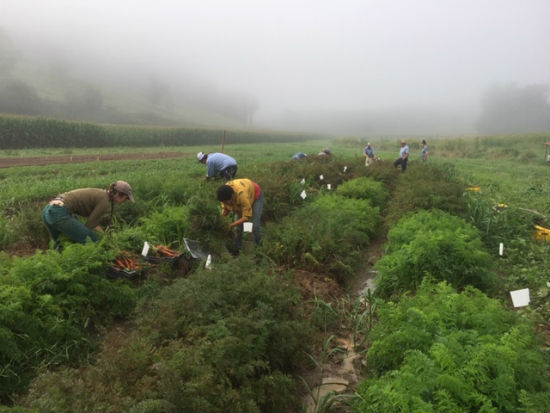
NC State U Gets USDA Grant to Improve Purple Carrots as Food Colorants

The demand for natural food colorants, such as anthocyanins, continues to grow in the United States and worldwide due to the health-promoting properties of plant pigments accompanied by a consumer shift away from synthetic food dyes.
Massimo Iorizzo, Ph.D., a North Carolina State University associate professor of plant genomics, was awarded a $637,000 grant from the United States Department of Agriculture National Institute of Food and Agriculture (USDA-NIFA) to increase anthocyanin yield in purple carrots and to improve anthocyanin longevity in food products.
The U.S. is the largest consumer and producer of natural food colorants. However, use of anthocyanins, a pigment found in red, blue and purple plant tissues, can be challenging due to varying yield, difficulty in color-matching a desired hue and concerns with color fastness for shelf life. There are more than 600 identified anthocyanins, some with more desirable traits for use as a food colorant than others.

One particularly promising source of anthocyanins for food colorants are purple carrots, due to their accumulation of large quantities of more-stable anthocyanin compounds. Most fresh market carrots available to consumers in the United States are orange; however, carrots that are red, yellow or purple are becoming more frequently available in fresh, frozen and juice products.
For the past five years, NC State has been involved in research originating and coordinated by the North Carolina Biotechnology Center and funded by the NC Department of Agriculture & Consumer Services New and Emerging Crops Program, investigating the feasibility of growing purple carrot varieties in different soil types, climates and growing seasons across North Carolina. According to Hunter Barrier, new and emerging crops program coordinator, "This research demonstrated that high-quality purple carrots can grow in North Carolina. Research continues to address production challenges and develop agronomic production recommendations for growing carrots in N.C."
There may be additional market potential for purple carrots. According to Paul Ulanch, Ph.D., executive director of NCBiotech’s Crop Commercialization Program, “Additional agribusinesses have expressed interest in the purple carrot trials for potential expansion of production for fresh-market carrots, juices, purees, and dried flours.”
In addition to assessing the agronomic and economic crop potential, postharvest carrot data collection included anthocyanin identification and quantification in collaboration with the NC Food Innovation Lab.
Iorizzo explains, “This grant will allow us to utilize genotyping and phenotyping to select carrot cultivars that can maximize anthocyanin yield and stability. Improving the purple carrot with anthocyanin extraction in mind is an important step in establishing it as a viable crop for our farmers and for the food ingredient market.”
There are no official statistics of worldwide purple carrot production, but the food industry estimates an annual need of 20 million pounds of carrot-derived anthocyanins to meet the growing demand. For comparison, according to the USDA’s National Agricultural Statistics Service, the U.S. produced 3.4 billion pounds of fresh-market carrots in 2020 valued at $10,600 per acre.
This project will be led by Iorizzo at the university’s Plants for Human Health Institute, at the North Carolina Research Campus in Kannapolis. Iorizzo led the publication of the carrot genome and he is now focusing his research on nutritional and quality trait improvement of blueberry and carrot using advanced genomic tools. Food scientist Mario Ferruzzi, Ph.D., director of the Arkansas Children’s Nutrition Center, is a collaborator on the project and will be characterizing the anthocyanin composition and studying their stability.
The work is supported by the AFRI Foundational and Applied Science Program, Grant no. 2022-67013-36389, from the USDA National Institute of Food and Agriculture.
